Abstract
1. The occupation in vivo by NKY-722 of 1,4-dihydropyridine (DHP) calcium antagonist receptors in myocardium, aorta and cerebral cortex was investigated. At 1 and 3 h after oral administration of NKY-722 (3 mg kg-1) in spontaneously hypertensive rats (SHR), there was a significant (44 and 41%, respectively) decrease in the number of myocardial (+)-[3H]-PN 200-110 binding sites (Bmax) compared to control values. A greater reduction of Bmax values was observed at 1 (86%), 3 (88%), 6 (63%) and 12 (46%) h later by a higher dose (10 mg kg-1) of this drug. The occupation of myocardial 1,4-DHP calcium antagonist receptors after oral administration of NKY-722 correlated significantly with its plasma concentration. There was a significant decrease in cerebral cortical (+)-[3H]-PN 200-110 binding (Bmax) at 1 and 3 h after oral administration of NKY-722 (10 mg kg-1). 2. Oral administration of nicardipine (10 mg kg-1) in SHR caused a significant reduction of Bmax values for (+)-[3H]-PN 200-110 binding in myocardium at 1 and 3 h later and in cerebral cortex at 1 h later. 3. The in vivo specific binding of (+)-[3H]-PN 200-110 in particulate fractions of aorta of SHR was significantly (79 and 83%, respectively) reduced at 1 and 6 h after oral administration of NKY-722 (3 mg kg-1), while myocardial (+)-[3H]-PN 200-110 binding was decreased by 52% only at 1 h later.(ABSTRACT TRUNCATED AT 250 WORDS)
Full text
PDF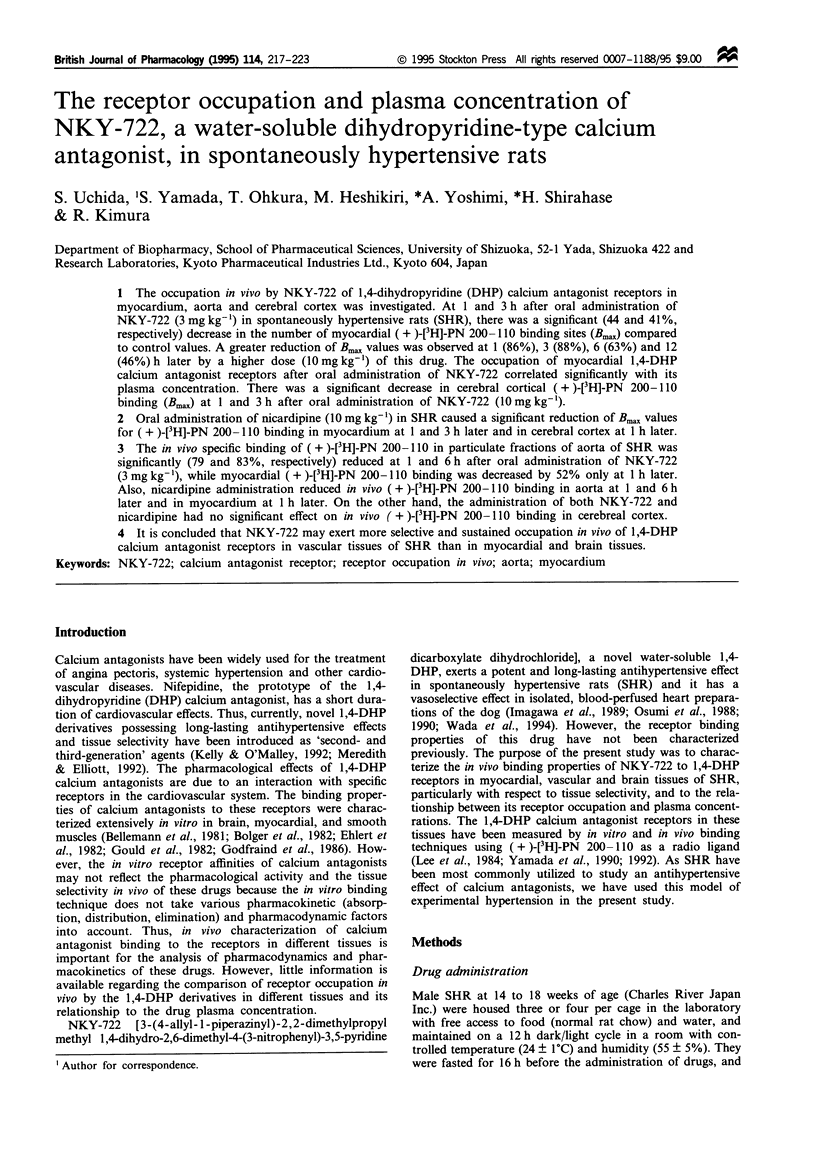
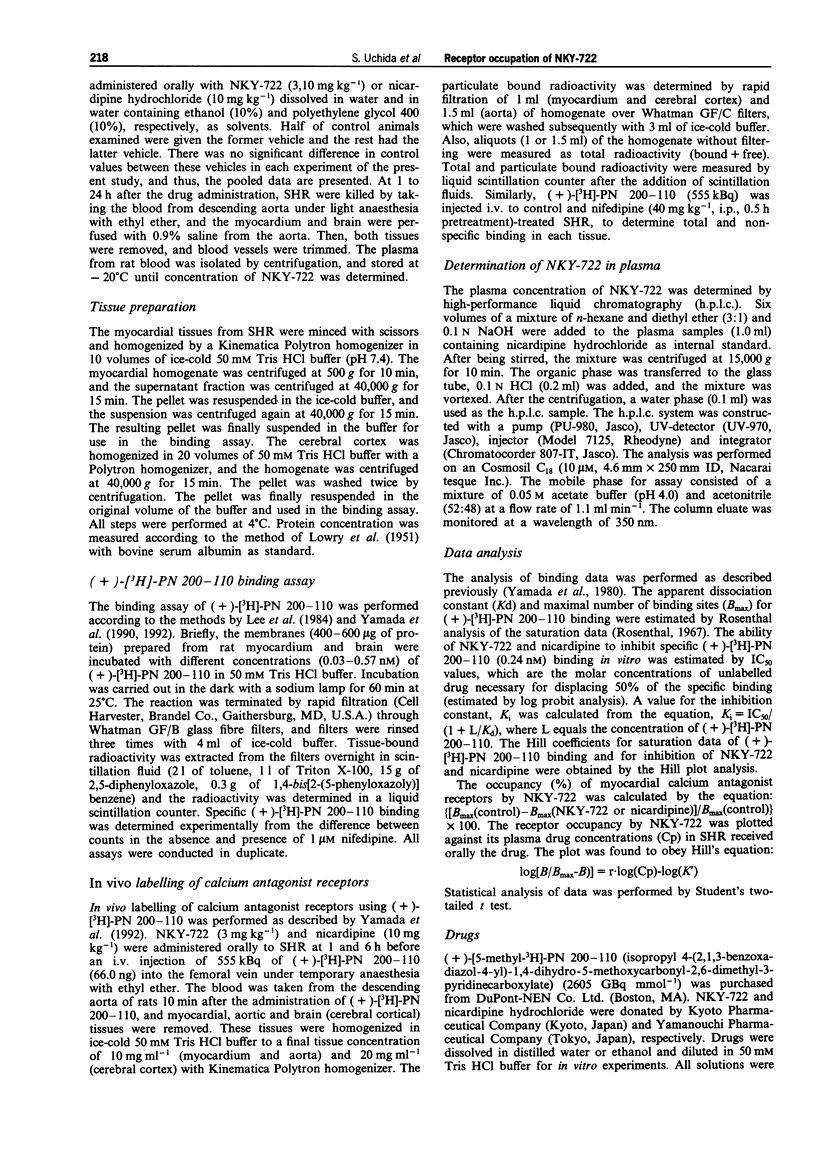
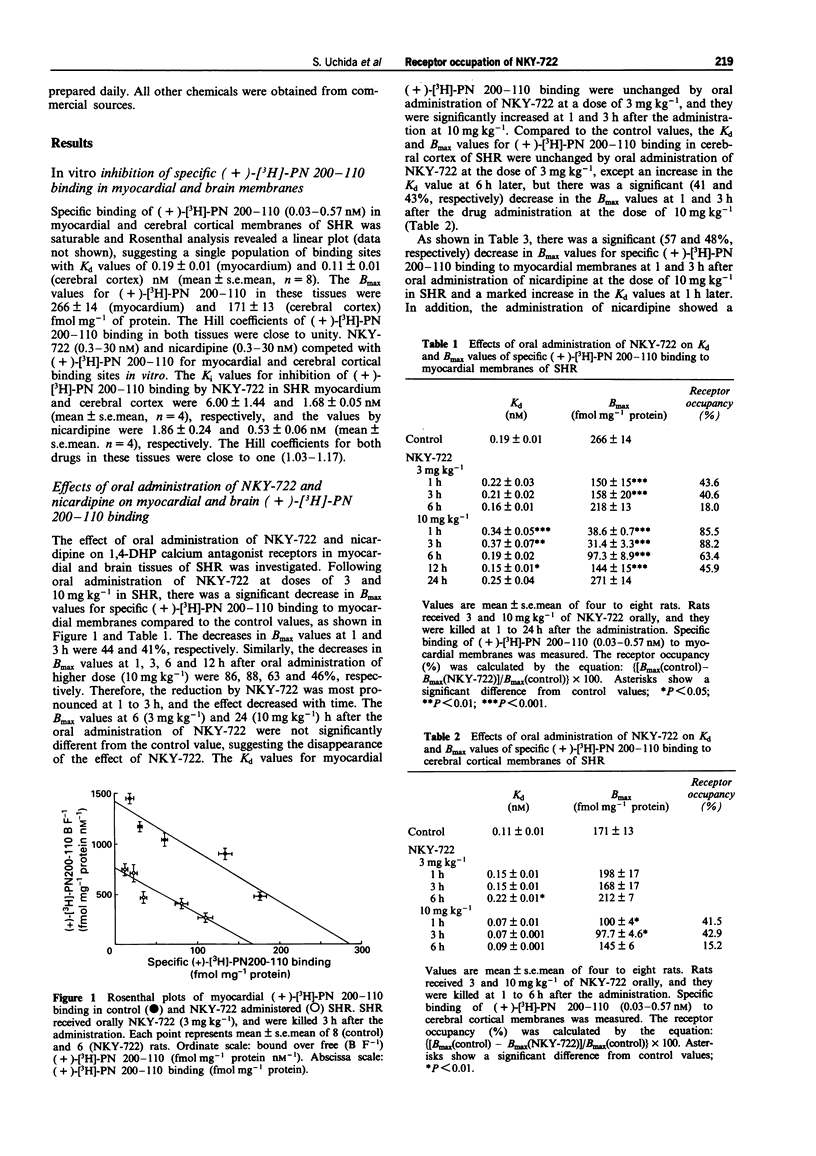
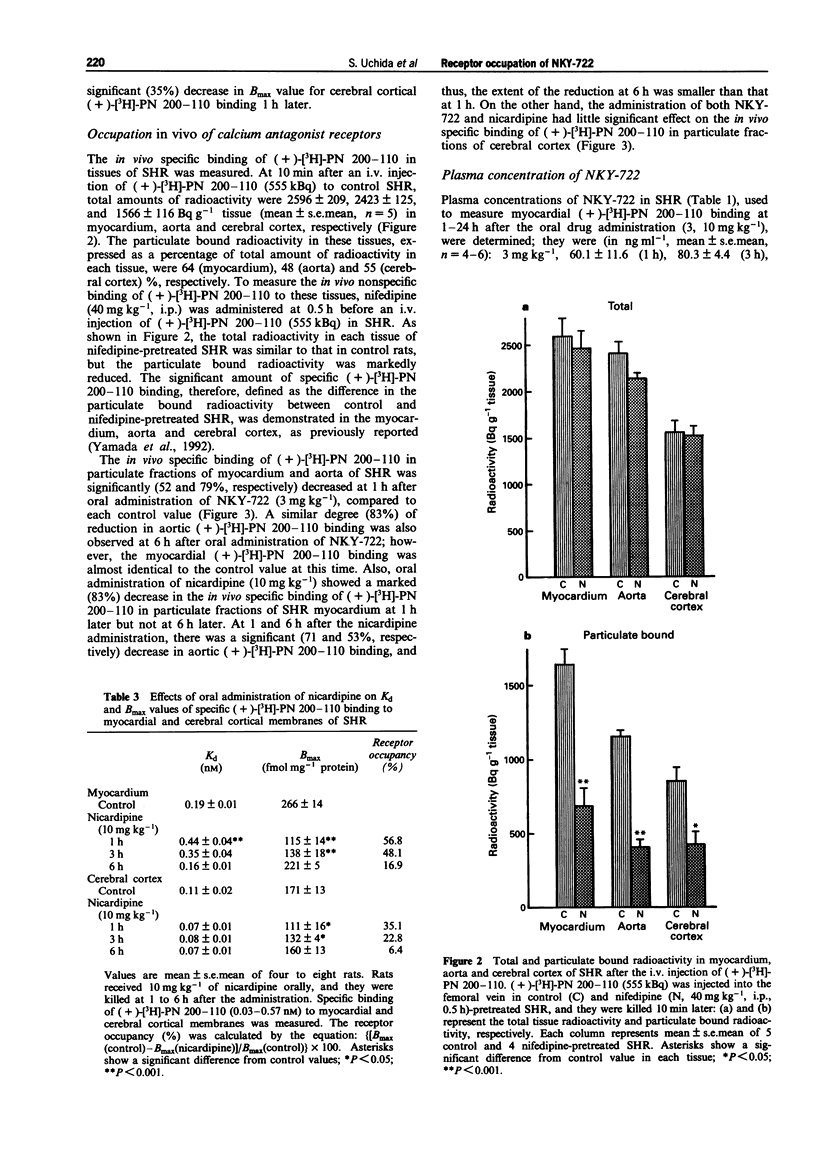
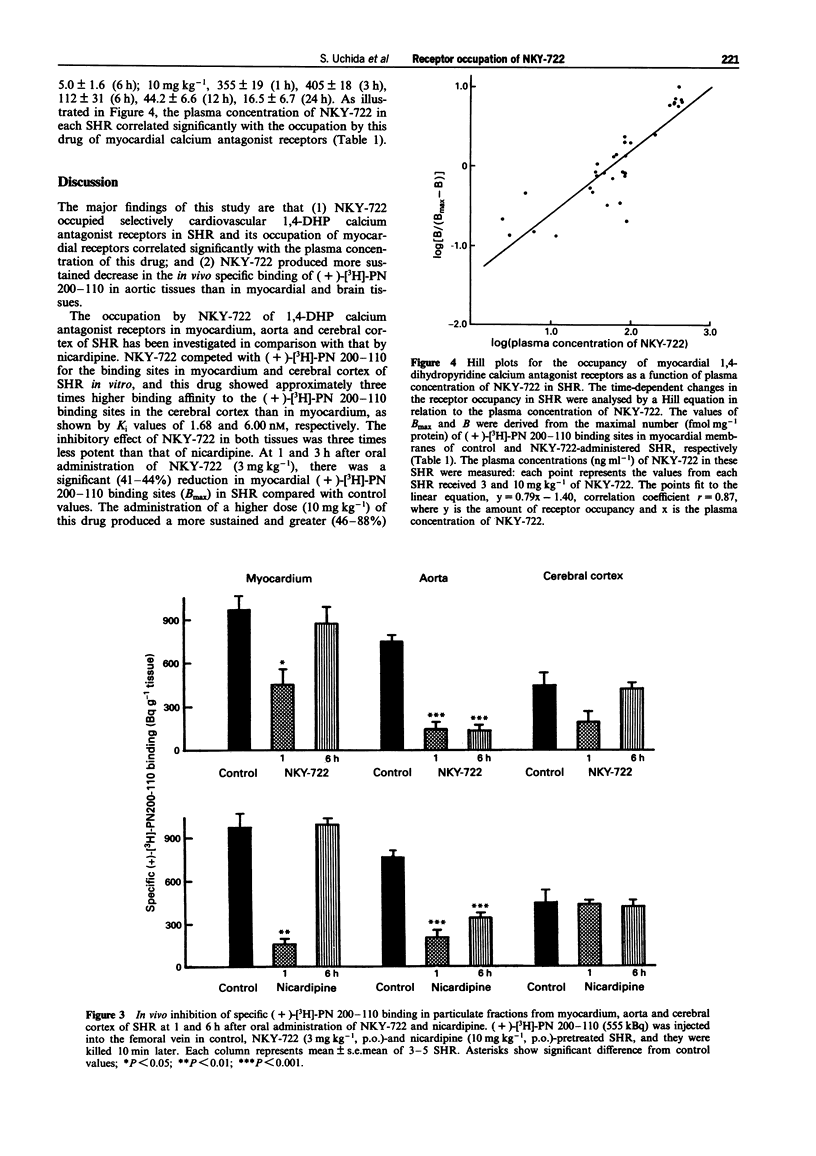
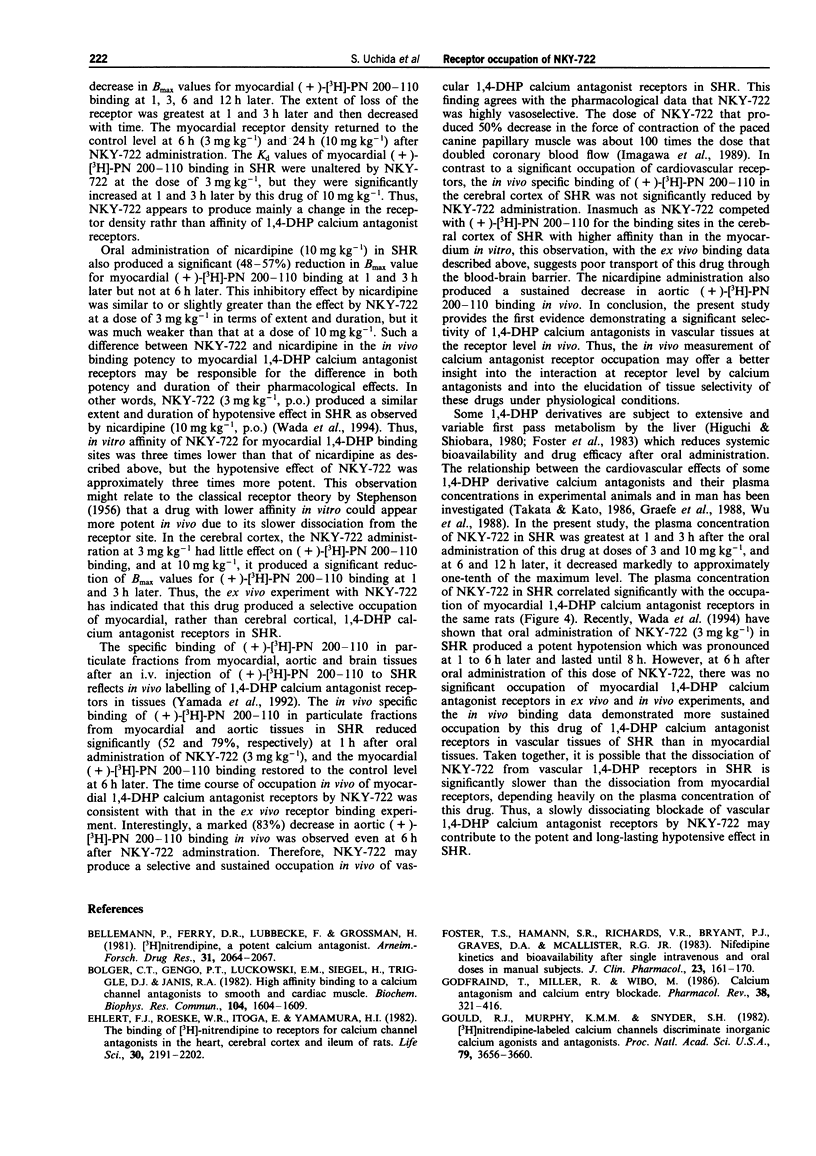
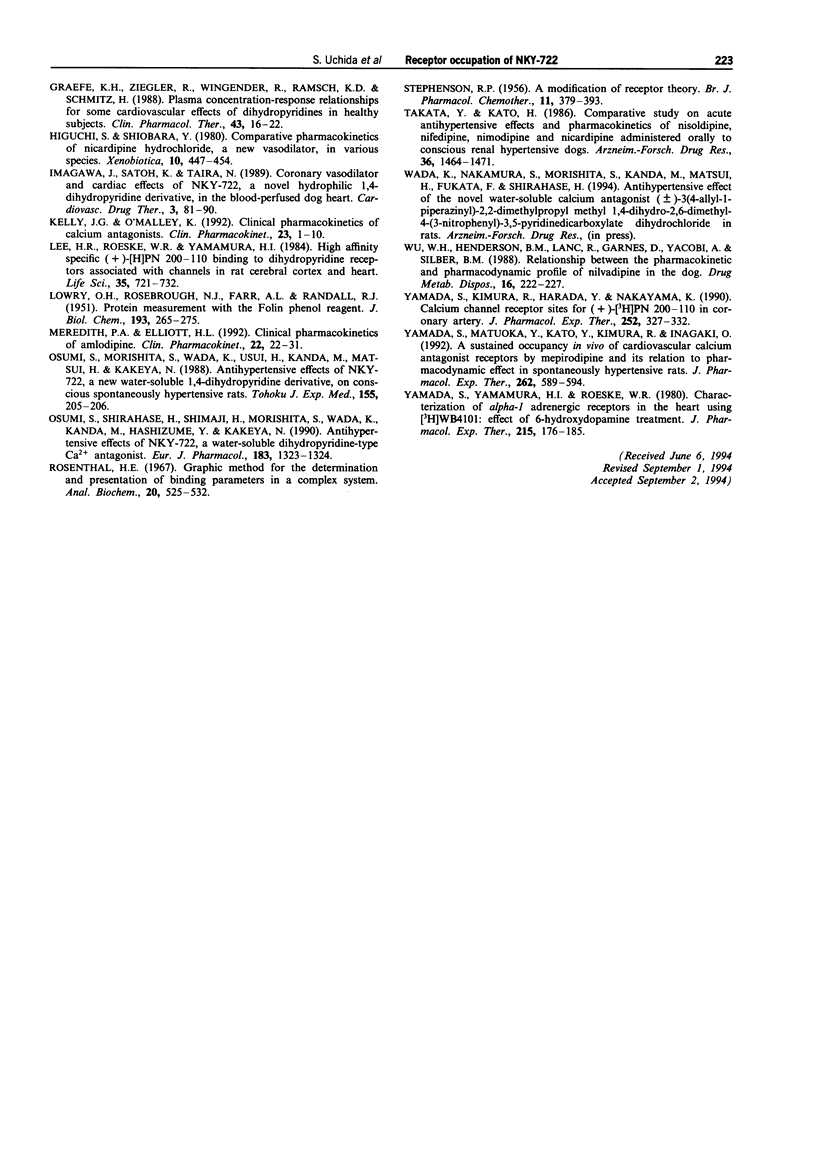
Selected References
These references are in PubMed. This may not be the complete list of references from this article.
- Bellemann P., Ferry D., Lübbecke F., Glossman H. [3H]-Nitrendipine, a potent calcium antagonist, binds with high affinity to cardiac membranes. Arzneimittelforschung. 1981;31(12):2064–2067. [PubMed] [Google Scholar]
- Bolger G. T., Gengo P. J., Luchowski E. M., Siegel H., Triggle D. J., Janis R. A. High affinity binding of a calcium channel antagonist to smooth and cardiac muscle. Biochem Biophys Res Commun. 1982 Feb 26;104(4):1604–1609. doi: 10.1016/0006-291x(82)91436-x. [DOI] [PubMed] [Google Scholar]
- Ehlert F. J., Roeske W. R., Itoga E., Yamamura H. I. The binding of [3H]nitrendipine to receptors for calcium channel antagonists in the heart, cerebral cortex, and ileum of rats. Life Sci. 1982 Jun 21;30(25):2191–2202. doi: 10.1016/0024-3205(82)90293-4. [DOI] [PubMed] [Google Scholar]
- Foster T. S., Hamann S. R., Richards V. R., Bryant P. J., Graves D. A., McAllister R. G. Nifedipine kinetics and bioavailability after single intravenous and oral doses in normal subjects. J Clin Pharmacol. 1983 Apr;23(4):161–170. doi: 10.1002/j.1552-4604.1983.tb02720.x. [DOI] [PubMed] [Google Scholar]
- Gilman J. T., Gal P. Pharmacokinetic and pharmacodynamic data collection in children and neonates. A quiet frontier. Clin Pharmacokinet. 1992 Jul;23(1):1–9. doi: 10.2165/00003088-199223010-00001. [DOI] [PubMed] [Google Scholar]
- Godfraind T., Miller R., Wibo M. Calcium antagonism and calcium entry blockade. Pharmacol Rev. 1986 Dec;38(4):321–416. [PubMed] [Google Scholar]
- Gould R. J., Murphy K. M., Snyder S. H. [3H]nitrendipine-labeled calcium channels discriminate inorganic calcium agonists and antagonists. Proc Natl Acad Sci U S A. 1982 Jun;79(11):3656–3660. doi: 10.1073/pnas.79.11.3656. [DOI] [PMC free article] [PubMed] [Google Scholar]
- Graefe K. H., Ziegler R., Wingender W., Rämsch K. D., Schmitz H. Plasma concentration-response relationships for some cardiovascular effects of dihydropyridines in healthy subjects. Clin Pharmacol Ther. 1988 Jan;43(1):16–22. doi: 10.1038/clpt.1988.6. [DOI] [PubMed] [Google Scholar]
- Higuchi S., Shiobara Y. Comparative pharmacokinetics of nicardipine hydrochloride, a new vasodilator, in various species. Xenobiotica. 1980 Jun;10(6):447–454. doi: 10.3109/00498258009033779. [DOI] [PubMed] [Google Scholar]
- Imagawa J., Satoh K., Taira N. Coronary vasodilator and cardiac effects of NKY-722, a novel hydrophilic 1,4-dihydropyridine derivative, in the blood-perfused dog heart. Cardiovasc Drugs Ther. 1989 Mar;3(1):81–90. doi: 10.1007/BF01881532. [DOI] [PubMed] [Google Scholar]
- LOWRY O. H., ROSEBROUGH N. J., FARR A. L., RANDALL R. J. Protein measurement with the Folin phenol reagent. J Biol Chem. 1951 Nov;193(1):265–275. [PubMed] [Google Scholar]
- Lee H. R., Roeske W. R., Yamamura H. I. High affinity specific [3H](+)PN 200-110 binding to dihydropyridine receptors associated with calcium channels in rat cerebral cortex and heart. Life Sci. 1984 Aug 13;35(7):721–732. doi: 10.1016/0024-3205(84)90340-0. [DOI] [PubMed] [Google Scholar]
- Meredith P. A., Elliott H. L. Clinical pharmacokinetics of amlodipine. Clin Pharmacokinet. 1992 Jan;22(1):22–31. doi: 10.2165/00003088-199222010-00003. [DOI] [PubMed] [Google Scholar]
- Osumi S., Morishita S., Wada K., Usui H., Kanda M., Matsui H., Kakeya N. Antihypertensive effect of NKY-722, a new water-soluble 1,4-dihydropyridine derivative, on conscious spontaneously hypertensive rats. Tohoku J Exp Med. 1988 Jun;155(2):205–206. doi: 10.1620/tjem.155.205. [DOI] [PubMed] [Google Scholar]
- Rosenthal H. E. A graphic method for the determination and presentation of binding parameters in a complex system. Anal Biochem. 1967 Sep;20(3):525–532. doi: 10.1016/0003-2697(67)90297-7. [DOI] [PubMed] [Google Scholar]
- STEPHENSON R. P. A modification of receptor theory. Br J Pharmacol Chemother. 1956 Dec;11(4):379–393. doi: 10.1111/j.1476-5381.1956.tb00006.x. [DOI] [PMC free article] [PubMed] [Google Scholar]
- Takata Y., Kato H. Comparative study on acute antihypertensive effects and pharmacokinetics of nisoldipine, nifedipine, nimodipine and nicardipine administered orally to conscious renal hypertensive dogs. Arzneimittelforschung. 1986 Oct;36(10):1464–1471. [PubMed] [Google Scholar]
- Wu W. H., Henderson B. M., Lanc R., Garnes D., Yacobi A., Silber B. M. Relationship between the pharmacokinetic and pharmacodynamic profile of nilvadipine in the dog. Drug Metab Dispos. 1988 Mar-Apr;16(2):222–227. [PubMed] [Google Scholar]
- Yamada S., Kimura R., Harada Y., Nakayama K. Calcium channel receptor sites for (+)-[3H]PN 200-110 in coronary artery. J Pharmacol Exp Ther. 1990 Jan;252(1):327–332. [PubMed] [Google Scholar]
- Yamada S., Matsuoka Y., Kato Y., Kimura R., Inagaki O. A sustained occupancy in vivo of cardiovascular calcium antagonist receptors by mepirodipine and its relation to pharmacodynamic effect in spontaneously hypertensive rats. J Pharmacol Exp Ther. 1992 Aug;262(2):589–594. [PubMed] [Google Scholar]
- Yamada S., Yamamura H. I., Roeske W. R. Characterization of alpha-1 adrenergic receptors in the heart using [3H]WB4101: effect of 6-hydroxydopamine treatment. J Pharmacol Exp Ther. 1980 Oct;215(1):176–185. [PubMed] [Google Scholar]


